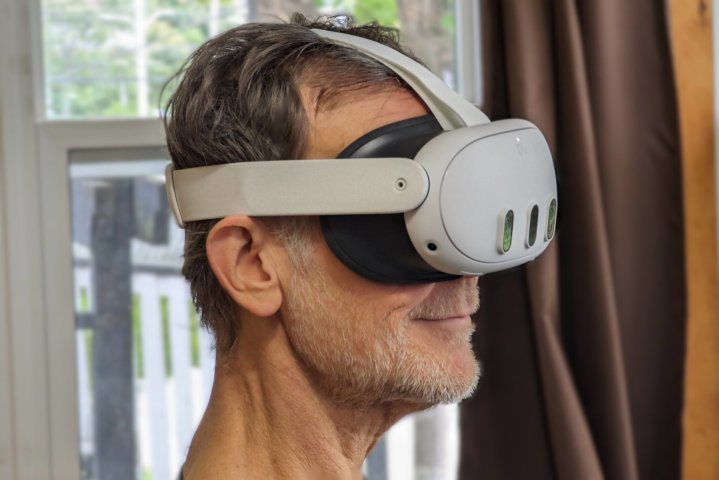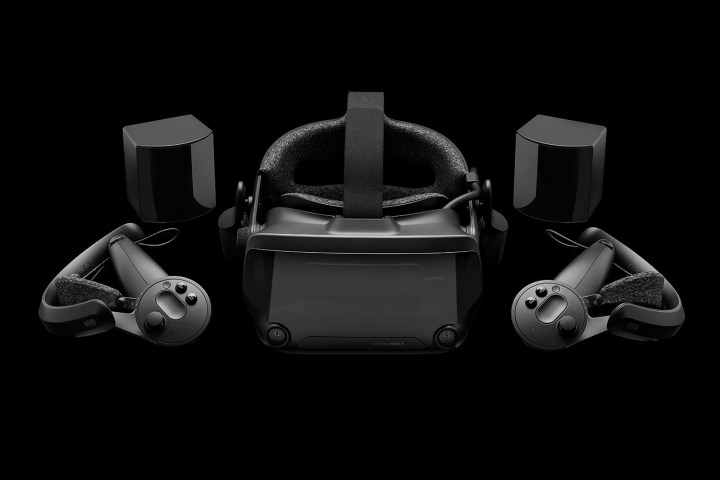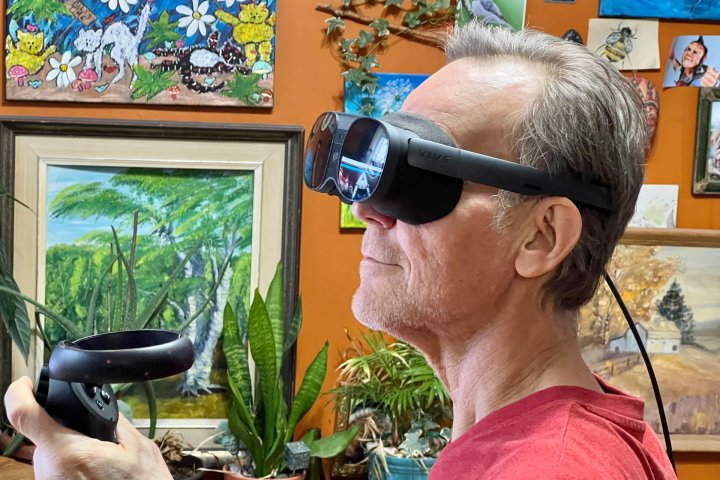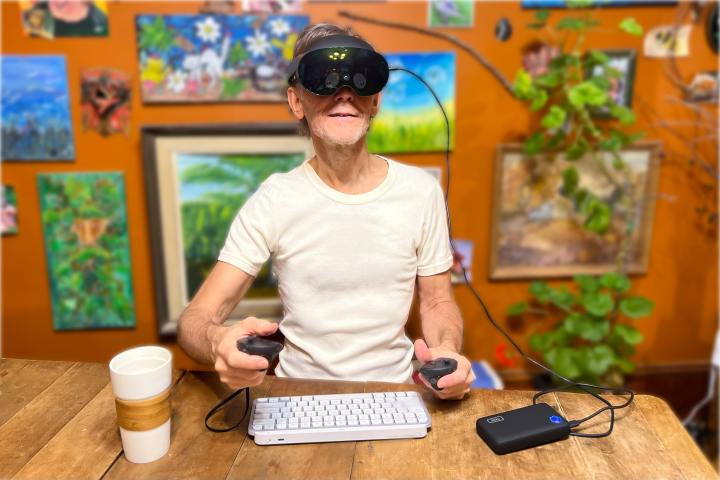
Picking out one of the best VR headsets can feel confusing if you’ve only just learned what VR is and where to begin with the technology. When it comes to finding the right VR headset for hooking up to your PC, the options are a little different from VR headsets for the PlayStation, for instance, so it’s important to know the distinction and buy the right one for your PC gaming needs.
We’re on hand with a look at the best VR headset for PC. It’s possible to spend thousands of dollars on a VR headset as well as just a few hundred bucks. Of course, in many cases, you get what you pay for so it could be a better idea to invest if you can. That’s why we’ve picked out a variety of different VR headsets so that you can easily pick out the right one to suit your budget and needs. Take a look below at what we recommend and be ready to enjoy some truly immersive gaming in no time.
The best VR headset for PC in 2024
- Buy the
if you want the best all-rounder VR headset - Buy the Valve Index https://store.steampowered.com/valveindex if you want room-scale VR
- Buy the
if you want high resolutions at a good price - Buy the
if you want a high-end experience - Buy the
if you want great picture quality - Buy the
if you want a budget VR headset
Meta Quest 3
Best all-rounder VR headset

| Pros | Cons |
| Crisp graphics and clear lens | Few extras included |
| Great depth sensor | Passthrough cameras could be better |
If you’ve only got time to consider one VR headset, go and buy the Meta Quest 3. It’s well-priced and has everything you could need from a great VR headset. It uses the Snapdragon XR Gen 2 processor so you get double the performance of the Quest 2. It also has a 4K+ Infinite Display with a nearly 30% leap in resolution from the Meta Quest 2, while there’s rich 3D audio with enhanced sound clarity, bass performance, and a 40% louder volume range than the previous model. The Infinity Display provides you with a resolution of 2064 x 2208 per eye so it’s super crisp with its pancake lenses providing plenty of clarity.
While some headsets stick solely to VR, the Meta Quest 3 branches out to offer mixed reality services too. It means your actual surroundings are shown within the headset through the use of color passthrough cameras on the front. It’s not perfect but it’s convincing and looks pretty good, right down to being able to use your phone while still wearing the headset.
Of course, the key highlight is being able to play the best games on Meta Quest 3. The supply is plentiful with titles like Asgard’s Wrath 2 proving to be a must-have and playing so much better on the Quest 3 than the Quest 2. A slim and ergonomic design rounds things off nicely so that the Meta Quest 3 is always super comfy to wear and use, even for extended periods.
| Specifications | |
|---|---|
| CPU | Snapdragon XR2 Gen 2 |
| Resolution | 2064 x 2208 |
Valve Index
Best for reliable tracking

| Pros | Cons |
| Wide field of view | SteamVR continues to have issues |
| Reliable tracking | Uses base stations |
You play most of your games via Steam so why not dive in and get your VR headset from Steam too. That’s the thinking behind the Valve Index which might be a few years old now but still offers a great experience. One of its highlights is its LCD display which looks great. A choice of either 120Hz or 144Hz refresh rates make a huge difference here and certainly makes it a VR headset that’s easier on the eyes thanks to improved smoothness.
One neat touch is being able to use dials to change the physical distance from the lens to your eyes, along with a typical option for making the headband tighter or looser. It’s all ideal for making things a little more personalized and appropriate for your face and head. The Valve Index uses base stations which is a little backwards compared to the competition but it’s worth taking the time to set things up as the Valve Index ends up very reliable.
Ensuring you’ll use the Valve Index for extended periods, the headset is pretty comfortable with weight distribution being good if not exceptional. There’s also good quality sound via the built-in headphones which immerse you in the experience while not bleeding outwards. A final crucial addition is great controllers with the Index Controllers feeling good in your hands. They strap to your limbs so you can completely let go and see your in-game hands open up. It’s an expensive but respectable headset to consider. For a highly immersive experience with a great field of view, you can’t go wrong with the Valve Index, provided you can afford it.
| Specifications | |
|---|---|
| CPU | Dual-core CPU with hyper-threading |
| Resolution | 1440 x 1600 |
https://store.steampowered.com/valveindex
HP Reverb G2
Best mid-range option

| Pros | Cons |
| Well-priced | Could be more accurate |
| Easy setup |
More affordable than many other VR headsets, the HP Reverb G2 is a good starting point if you have a powerful PC and you want to check out VR gaming. It’s very easy to set up although there are a plentiful supply of wires to get things hooked up correctly.
It offers 4K resolutions for each eye so you get great image clarity with a wide field-of-view too. The horizontal field of view is between 80 and 90 degrees while vertical is ever so slightly lower. There’s no screen door effect either, ensuring the image quality is exceptional. The refresh rate tops out at 90Hz which is pretty great for the price while there’s a physical slider for adjusting distance for your eyes.
The HP Reverb G2 all feels comfy too with velcro straps and padding keeping you snug, while the headband allows for the display to flip up which is convenient. It’s lightweight and feels fine on your face, while audio is provided through speakers that are a tiny bit away from your ears. The controllers work well too, even if they lack capacitive touch functionality. They feel good in your hands though with buttons like the grip positioned well, along with the trigger too. Tracking could be slightly better but it’s mostly effective and not the end of the world. There are trade-offs for an affordable 4K VR headset and this is one of them. For the most part though, the HP Reverb G2 is a good way of enjoying 4K levels of quality without spending a fortune. Just make sure your PC can handle processing such high-resolution imagery. You’re sure to need one of the best gaming desktop PCs to reap the benefits.
| Specifications | |
|---|---|
| CPU | N/A |
| Resolution | 2160 x 2160 |
HTC Vive XR Elite
Best high-end experience

| Pros | Cons |
| Very comfy | Expensive |
| Great mixed reality | Poor controllers |
Well-designed, the HTC Vive XR Elite can be used as a standalone VR headset but it can also be used with your PC. It’s one of the lightest VR headsets around and you can also connect to a PC wirelessly, saving you from needing to use cumbersome cables. Each eye offers a display resolution of 1920 x 1920 which is more than respectable enough. It also uses pancake lenses with built-in diopter adjustment so you get great clarity. When used standalone, it works for about two hours with the option to move around untethered.
At all times, you can adjust the IPD and diopter dials to your needs so you get the most natural and clearest experience for your sessions. There’s up to a 110-degree field of view along with a 90Hz refresh rate so it’s clear and crisp, even when the action is moving fast. It’s incredibly comfy with just a single dial for tightening and loosening without the need for more. You can also opt to remove the battery cradle at the back if you want to make things lighter. By doing so, it’s like you’re wearing glasses.
Mixed reality works well too with full-color passthrough using the external cameras and depth sensors to give you a view of the world from outside your headset. It’s not perfect with depth perception ever so slightly off but it’s still useful. Adding to the variety that the HTC Vive XR Elite offers, it’s also good for app use as well as the best HTC Vive games. The downside to all of this? The controllers feel weirdly cheap for such a premium headset and they ruin the immersion a little.
| Specifications | |
|---|---|
| CPU | Snapdragon XR2 Gen |
| Resolution | 1920 x 1920 |
Meta Quest Pro
Best for picture quality

| Pros | Cons |
| Fantastic pancake lenses | Needs regular charging |
| Excellent controllers |
If you can afford it, read up on the differences between the Meta Quest Pro and the Quest 2 and invest in the more premium option. You won’t regret it. It’s overkill for some users but if you want all the benefits that a VR headset can provide, this is the solution. It can almost work as a replacement to your desktop with a truly great new perspective on your work as well as for collaborating and gaming purposes. Its 1800 x 1920 resolution is good for gaming as well as productivity with contrast and vibrancy looking great thanks to its mini-LED backlighting. Said panels offer 37% more pixels per inch, along with 10% more pixels per degree, and 75% better contrast compared to previous Quest headsets.
The Meta Quest Pro also has great hand tracking so you don’t have to use controllers if you don’t want to. Visually, it looks great with a few refinements soon leading to an incredibly sharp image via the pancake lenses. It might only be capped at 90Hz for the refresh rate but it still looks pretty sharp and blur-free. There’s also color passthrough so you can benefit from mixed-reality options with the image a little grainy but otherwise still pretty good.
Other functionality comes from the Meta Quest Pro’s eye and face tracking which works well in both gaming and when using work-related apps. The only downside to so much power is that the Meta Quest Pro’s battery life is pretty weak. Expect only about 90 minutes to two hours at most meaning you’ll likely need to add on the Elite Strap with battery to truly be able to use it for any length of time.
| Specifications | |
|---|---|
| CPU | Snapdragon XR2+ Gen 1 |
| Resolution | 1800 x 1920 |
Meta Quest 2
Best budget VR headset

| Pros | Cons |
| Very affordable | Controllers aren’t rechargeable |
| Good design |
The Meta Quest 2 doesn’t offer the latest VR technology anymore but taking a look at the best Meta Quest 2 games demonstrates how much potential is still out there. Its Snapdragon XR2 is still pretty speedy if not the fastest around. Popular games will run without a hitch while it also works well with many apps. The resolution may not be the sharpest but it’s good enough and the 120Hz refresh rate works well at cutting down on the risk of motion blur or motion sickness.
Design-wise, the Meta Quest 2 is a little bulkier than newer models but it’s reasonably light with a simple strap and four camera sensors on the headset. It’s possible to adjust the spacing of the lenses with a choice of settings so you can get things just how you like them.
Besides the truly immersive side of things, you can also use the Meta Quest 2 in Passthrough mode the moment you leave your boundary and it’s reasonably clear and vibrant. Where things falter is with the controllers. They’re reasonably good quality with strong gesture tracking but they rely on regular AA batteries which isn’t entirely convenient. Still, the triggers are snappy and they’re comfy to grip onto. Battery life on the controllers is far superior than the headset at least with the latter weighing in at about 2-3 hours depending on what you’re doing.
Rounding things off well, let’s not forget the built-in audio. It’s positional in nature and sounds crisp and loud. There’s always a 3.5mm jack if you want to connect any headphones instead.
| Specifications | |
|---|---|
| CPU | Snapdragon XR2 |
| Resolution | 1832 x 1920 |
How we chose these VR headsets for PCs
Picking a VR headset to use with your PC is a big deal. Like buying a laptop or TV, a VR headset can be relatively affordable but it can also be an expensive investment. How much you should spend all depends on what you need from your VR headset. However, it’s also important to consider some key factors before buying a VR headset. We’ve thought about some vital elements and these are what we’ve used while evaluating what the best VR headsets for PC are. If you want to understand our thought process and take some lessons you can use in your own purchase session, keep reading.
Ultimately, budget is a fundamental part of your VR headset buying plans. As you can see, you can spend under $300 on a VR headset but you can also spend over $1,000. How do you know what you should do? For many people, if it’s your first VR headset, it doesn’t entirely make sense to spend thousands on a new headset, at least not unless you have plenty of prior experience with VR technology. Instead, aiming for a mid-range or even budget VR headset works well as a starter device for many people. In many cases, outside of professional purposes, a cheaper headset will suffice for most people and purposes.
Alongside the budgetary concerns, think about how sharp an image you need or want. Something like the HP Reverb G2 can offer 4K resolutions at an affordable price but often, you’ll need to spend much more for higher resolutions. Not everyone needs it but if you suffer from motion sickness while using a VR headset, aiming for something more high-end can stop such issues from arising as the image feels more natural.
It’s also useful to consider if you need a VR headset that can also work standalone or if you’re fine for it to work solely attached to your PC. This all depends on your intentions so only you know the answer here. If you want to wear the VR headset out and about then, of course, you’ll need something that doesn’t depend on your PC.
Don’t forget about battery life either. While the VR headset may be attached to your PC, it’s still always useful to be able to go wires-free. It feels more liberating and immersive compared to being constrained by cables. Also, if you do plan on using it away from your PC sometimes, you don’t want weak battery life letting you down.
Finally, don’t forget comfort. We picked VR headsets that are mostly very comfortable. If you’re wearing something on your head, you don’t want it to drag you down or cause you neck ache. Instead, we’ve focused on those headsets that you can actually wear for a while without regretting it. In conjunction with that, a plentiful supply of ways to tweak the way you wear and use the headset go a long way to providing you with a more personal experience. Crucially, one that means you’ll keep coming back to use the best VR headset for PC.
This article is managed and created separately from the Digital Trends Editorial team.
Editors’ Recommendations




